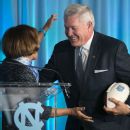“You start asking yourself, why coach again?” Brown said. “Maybe you’ve done enough.”
Brown came of age as a coach at North Carolina. He left Tulane in 1987 to take the job based on advice he had received from Texas coaching icon Darrell Royal, who told him to always take a job at a school with “The” at the beginning of its name. A decade later, Royal himself implored Brown to leave Carolina and come to “The” University of Texas. Brown took the Longhorns to the 2005 national championship.
As of Tuesday, after five years on the outside looking in, Brown not only has returned to coaching, he has returned to one of his old jobs. The News and Observer reported that Brown has agreed to a five-year contract at about $3.5 million a year. That would be roughly 10 times the $375,000 salary Carolina paid him in his final season some two decades ago.
BROWN said he missed the relationships with players. He missed having a staff. He would work to communicate with his new team in order to build trust and respect. Brown praised his predecessor, Larry Fedora, and said Fedora’s son Dylan, a quality control assistant this season, is welcome to remain on staff.
And he said he planned to win games, something the Tar Heels did only five times in the last two seasons.
“I’ve tried that both ways,” Brown said. “Winning’s a lot more fun than that other stuff.”
If history is any guide, Brown will struggle to win as many games as he did the first time he coached at North Carolina (69-46-1, .599, 1988-97). Among the modern college or pro Hall of Fame coaches who have returned to their campuses, Johnny Majors (Pitt), John Robinson (USC), Bill Snyder (Kansas State) and even the haloed Bill Walsh (Stanford) all had poorer win-loss records their second time around. Chris Ault (Nevada), who retired twice, actually didn’t falter until his third go-round.
Mack Brown won at North Carolina the first time. Historically, sustaining that success a second time is much harder. Robert Willett/The News & Observer via AP
It’s not that they didn’t succeed upon their returns. With the notable exception of Majors, who went 12-32 in four seasons upon returning to Pitt, the rest won 10 games or more at least once. It’s that they didn’t regenerate the sustained success that made them desirable on their old campuses.
Walsh had the luxury of taking over a winning program. His predecessor, Denny Green, left for the NFL. But Walsh been away from coaching for three seasons, and away from the college game for 13, when he returned to Stanford in Jan. 1992. Walsh, a self-doubter by nature, worried that he no longer could reach college-age players, worried that he wouldn’t be able to think quickly enough on the sideline, and worried that he wouldn’t be able to sustain the focus he would need for the length of the game.
“I’ve lost something,” Walsh said in August, according to Rough Magic, Lowell Cohn’s riveting account of Walsh’s first season. “I know that. I’m just not sure what. Maybe it’s because I’m 60. I don’t know. I’m nervous. I admit it.”
Walsh led the Cardinal to a 10-3 record in 1992, Stanford’s first 10-win season since the Wow Boys went 10-0 and won a share of the 1940 national championship. But the Cardinal went 7-14-1 in the next two seasons and Walsh quietly retired.
And so it went. Robinson took USC to the Rose Bowl in the third season of his second tenure, then went 12-11 over the next two seasons and was fired. Snyder won a Big 12 Championship in 2012, the fourth year of his return, and has treaded water in the six seasons since (45-32 overall, 29-25 in conference play).
Ault went 173-58-1 (.748) in his first two runs as Nevada head coach (1976-92, 1994-5), including a I-AA (FCS) national championship in 1990 and shepherding the Wolf Pack into I-A (FBS). As athletic director, he rehired himself again in 2004, and over nine seasons won consistently (70-40, .636), if not as much as before. Nevada went 13-1 and finished No. 11 in 2010, and Ault retired on his own terms a year later.
Brown is aware of how rare that is. A month before his Texas Longhorns won that national championship over USC in one of the most thrilling games ever played, Brown, then 55 years old and on the top of his profession, said, “Very few coaches get to decide where they want to finish. And that’s a real pressure point for a coach in his 50s and 60s, when he doesn’t have a place to stop.”
Brown has found a place, if not to stop, then to start again, and a familiar place at that. He met and married his wife Sally during his first tenure in Chapel Hill. Brown joked that Sally told him the only places she would leave Austin in order for him to coach were Hawaii, the Bahamas, or Chapel Hill.
“We wanted to coach, and we wanted to coach here,” Brown said. “This is the only place we would have gotten back in coaching to do, because the place is so special to us. We love challenges…. It gives us an opportunity to fix things, and we love to fix things.”
A few minutes later, in response to a question, Brown added, “For me, it is more fun to fix than maintain.”
Therein lies the issue. Maintaining is what keeps coaches employed. But one thing at a time.
Powered by WPeMatico


